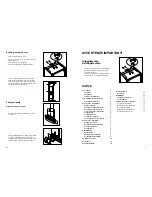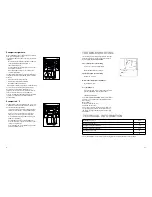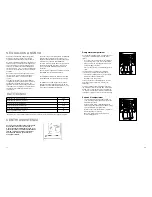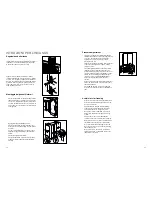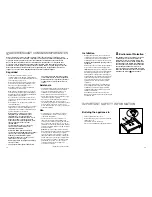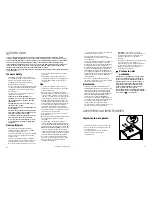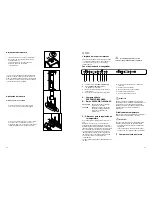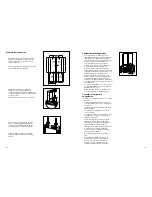
17
Importante:
en caso de que el cable de
alimentación se dañe, deberá ser sustituido con
un cable especial. Ambos cables pueden ser
solicitados al fabricante o al Servicio de
asistencia.
•
Si el aparato es transportado en forma horizontal
es posible que el aceite contenido en el
compresor pase al circuito refrigerante. Esperar
por lo menos dos horas antes de poner en
marcha el aparato para dar tiempo a que el
aceite regrese al compresor.
Protección del
ambiente
Este aparato no contiene en el circuito refrige-
rante y en el aislamiento, gases refrigerantes
nocivos para el ozono. El aparato no debe ser
eliminado junto con los deshechos urbanos y
chatarras. Se debe evitar el dano del circinto
refrigerante, sobre todo en la parte posterior
cerca del intercambiador. Las informaciones
sobre los centros de recepciõn son
suministradas por las autoridades municipales;
Los materiales usados en este aparato marcados
con el simbolo
son reciclables.
• Los productos que hayan sido descongelados no
se tienen que volver a congelar
• Seguir atentamente las indicaciones del
fabricante para la conservación y/o congelación
de los alimentos.
•
En todos los aparatos de refrigeración y congelación
existen superficies que se cubren con escarcha.
Según el modelo, la escarcha puede ser eliminada
automáticamente (desescarche automático) o
manualmente. No intentar nunca quitar la escarcha
con un objeto puntiagudo ya que se podría dañar
irremediablemente el evaporador. Utilizar para ello
sólo el rascador de plástico que se suministra con el
aparato. Por el mismo motivo no despegar nunca las
cubetas del hielo con un cuchillo o cualquier otro
objeto puntiagudo.
•
No colocar en el compartimiento de la baja
temperatura (congelador o conservador) bebidas
gaseosas que podrían explotar.
Instalación
• El aparato se calienta considerablemente en la
proximidad del condensador y del compresor, por lo
tanto hay que verificar que el aire pueda circular
libremente alrededor del mismo. Una ventilación
insuficiente puede causar un mal funcionamiento y
daños al aparato. Seguir cuidadosamente las
instrucciones que se dan para la instalación.
Por motivos de seguridad la ventilación debe ser
efectuada como se indica en la respectiva figura.
Atención: mantener las aperturas para la
ventilación libres de cualquier obstáculo.
•
Una vez instalado el aparato verificar que no esté
apoyado sobre el cable de alimentación.
1
2
ADVERTENCIAS IMPORTANTES
Alojamiento del aparato
•
Introducir el aparato en el espacio del mueble.
•
Hacer girar 180° la escuadra para obtener la
posición exacta ( 2).
La posición inicial (1) es la de expedición.
•
Fijario a la pared con la escuadra
correspondiente.
32
WARNINGS
Printed on recycled paper
It is most important that this instruction book should be retained with the appliance for future
reference. Should the appliance be sold or transferred to another owner, or should you move house
and leave the appliance, always ensure that the book is supplied with the appliance in order that the
new owner can be acquainted with the functioning of the appliance and the relevant warnings.
If this appliance featuring magnetic door seals is to replace an older appliance having a spring lock
(latch) on the door or lid, be sure to make that spring lock unusable before you discard the old
appliance. This will prevent it from becoming a death-trap for a child.
These warnings are provided in the interest of safety. You must read them carefully before installing or
using the appliance.
General Safety
• This appliance is designed to be operated by
adults. Children should not be allowed to tamper
with the controls or play with the product.
• It is dangerous to alter the specifications or
modify this product in any way.
• Before any cleaning or maintenance work is carried
out, be sure to switch off and unplug the appliance.
• This appliance is heavy. Care should be taken
when moving it
• Ice lollies can cause frost burns if consumed
straight from the appliance.
•
Take utmost care when handling your
appliance so as not to cause any damages to
the cooling unit with consequent possible
fluid leakages.
•
The appliance must not be located close to
radiators or gas cookers.
•
Avoid prolonged exposure of the appliance to
direct sunlight.
•
There must be adequate ventilation round the
back of the appliance and any damage to the
refrigerant circuit must be avoided.
•
For freezers only (except built-in models): an
ideal location is the cellar or basement.
•
Do not use other electrical appliances (such
as ice cream makers) inside of refrigerating
appliances.
Service/Repair
• Any electrical work required to install this
appliance should be carried out by a qualified
electrician or competent person
• This product should be serviced by an authorized
Service Centre, and only genuine spare parts
should be used.
• Under no circumstances should you attempt to
repair the appliance yourself. Repairs carried out
by inexperienced persons may cause injury or
more serious malfunctioning. Refer to your local
Service Centre, and always insist on genuine
spare parts.
•
This appliance contains hydrocarbons in its
cooling unit; maintenance and recharging must
therefore only be carried out by authorized
technicians.
Use
•
The domestic refrigerators and freezers are
designed to be used specifically for the storage of
edible foodstuffs only.
•
Best performance is obtained with ambient
temperature b18°C and +43°C (class T);
+18°C and +38°C (class ST); +16°C and +32°C
(class N); +10°C and +32°C (class SN). The class
of your appliance is shown on its rating plate.
Warning: when the ambient temperature is not
included within the range indicated for the class
of this appliance, the following instructions must
be observed: when the ambient temperature
drops below the minimum level, the storage
temperature in the freezer compartment cannot
be guaranteed; therefore it is advisable to use the
food stored as soon as possible.
•
Frozen food must not be re-frozen once it has
been thawed out.
•
Manufacturers’ storage recommendations should
be strictly adhered to. Refer to relevant
instructions.
•
The inner lining of the appliance consists of
channels through which the refrigerant passes. If
these should be punctured this would damage the
appliance beyond repair and cause food loss. DO
NOT USE SHARP INSTRUMENTS to scrape off
frost or ice. Frost may be removed by using the
scraper provided. Under no circumstances should
solid ice be forced off the liner. Solid ice should be
allowed to thaw when defrosting the appliance.
•
Do not place carbonated or fizzy drinks in the
freezer as it creates pressure on the container,
which may cause it to explode, resulting in
damage to the appliance.

